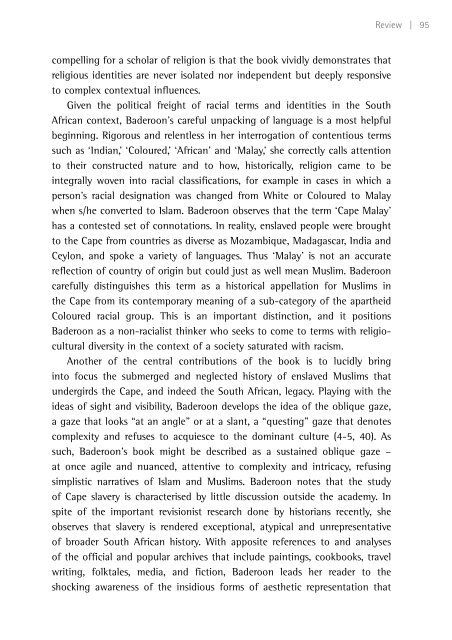The politics of fashion and beauty in Africa
fa21_proof_3
fa21_proof_3
Create successful ePaper yourself
Turn your PDF publications into a flip-book with our unique Google optimized e-Paper software.
compell<strong>in</strong>g for a scholar <strong>of</strong> religion is that the book vividly demonstrates that<br />
religious identities are never isolated nor <strong>in</strong>dependent but deeply responsive<br />
to complex contextual <strong>in</strong>fluences.<br />
Given the political freight <strong>of</strong> racial terms <strong>and</strong> identities <strong>in</strong> the South<br />
<strong>Africa</strong>n context, Baderoon’s careful unpack<strong>in</strong>g <strong>of</strong> language is a most helpful<br />
beg<strong>in</strong>n<strong>in</strong>g. Rigorous <strong>and</strong> relentless <strong>in</strong> her <strong>in</strong>terrogation <strong>of</strong> contentious terms<br />
such as ‘Indian,’ ‘Coloured,’ ‘<strong>Africa</strong>n’ <strong>and</strong> ‘Malay,’ she correctly calls attention<br />
to their constructed nature <strong>and</strong> to how, historically, religion came to be<br />
<strong>in</strong>tegrally woven <strong>in</strong>to racial classifications, for example <strong>in</strong> cases <strong>in</strong> which a<br />
person’s racial designation was changed from White or Coloured to Malay<br />
when s/he converted to Islam. Baderoon observes that the term ‘Cape Malay’<br />
has a contested set <strong>of</strong> connotations. In reality, enslaved people were brought<br />
to the Cape from countries as diverse as Mozambique, Madagascar, India <strong>and</strong><br />
Ceylon, <strong>and</strong> spoke a variety <strong>of</strong> languages. Thus ‘Malay’ is not an accurate<br />
reflection <strong>of</strong> country <strong>of</strong> orig<strong>in</strong> but could just as well mean Muslim. Baderoon<br />
carefully dist<strong>in</strong>guishes this term as a historical appellation for Muslims <strong>in</strong><br />
the Cape from its contemporary mean<strong>in</strong>g <strong>of</strong> a sub-category <strong>of</strong> the apartheid<br />
Coloured racial group. This is an important dist<strong>in</strong>ction, <strong>and</strong> it positions<br />
Baderoon as a non-racialist th<strong>in</strong>ker who seeks to come to terms with religiocultural<br />
diversity <strong>in</strong> the context <strong>of</strong> a society saturated with racism.<br />
Another <strong>of</strong> the central contributions <strong>of</strong> the book is to lucidly br<strong>in</strong>g<br />
<strong>in</strong>to focus the submerged <strong>and</strong> neglected history <strong>of</strong> enslaved Muslims that<br />
undergirds the Cape, <strong>and</strong> <strong>in</strong>deed the South <strong>Africa</strong>n, legacy. Play<strong>in</strong>g with the<br />
ideas <strong>of</strong> sight <strong>and</strong> visibility, Baderoon develops the idea <strong>of</strong> the oblique gaze,<br />
a gaze that looks “at an angle” or at a slant, a “quest<strong>in</strong>g” gaze that denotes<br />
complexity <strong>and</strong> refuses to acquiesce to the dom<strong>in</strong>ant culture (4-5, 40). As<br />
such, Baderoon’s book might be described as a susta<strong>in</strong>ed oblique gaze –<br />
at once agile <strong>and</strong> nuanced, attentive to complexity <strong>and</strong> <strong>in</strong>tricacy, refus<strong>in</strong>g<br />
simplistic narratives <strong>of</strong> Islam <strong>and</strong> Muslims. Baderoon notes that the study<br />
<strong>of</strong> Cape slavery is characterised by little discussion outside the academy. In<br />
spite <strong>of</strong> the important revisionist research done by historians recently, she<br />
observes that slavery is rendered exceptional, atypical <strong>and</strong> unrepresentative<br />
<strong>of</strong> broader South <strong>Africa</strong>n history. With apposite references to <strong>and</strong> analyses<br />
<strong>of</strong> the <strong>of</strong>ficial <strong>and</strong> popular archives that <strong>in</strong>clude pa<strong>in</strong>t<strong>in</strong>gs, cookbooks, travel<br />
writ<strong>in</strong>g, folktales, media, <strong>and</strong> fiction, Baderoon leads her reader to the<br />
shock<strong>in</strong>g awareness <strong>of</strong> the <strong>in</strong>sidious forms <strong>of</strong> aesthetic representation that<br />
Review | 95



